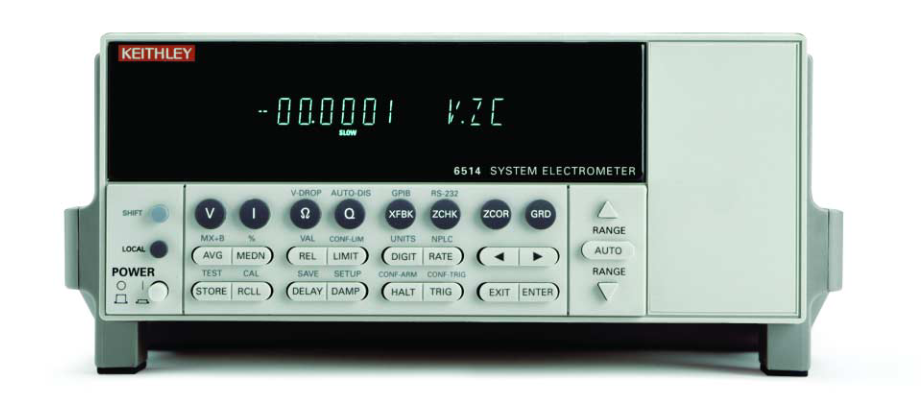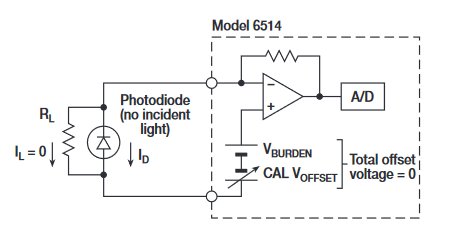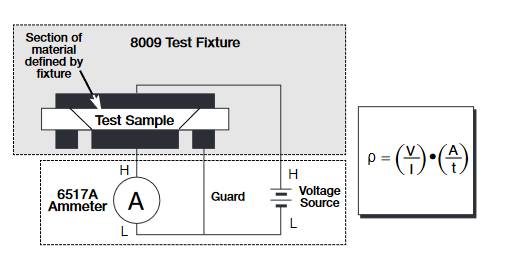Keithley has more than a half-century of experience in designing and producing sensitive instrumentation. As new testing requirements have evolved, we've developed dozens of different models to address our customers needs for higher resolution, accuracy, and sensitivity, as well as support for specific applications. Keithley electrometers are at work around the world in production test applications, industrial R&D centers, and university and government laboratories wherever people need to make high precision current, voltage, resistance, or charge measurements.
What is an electrometer?
Essentially, an electrometer is a highly refined digital multimeter (DMM). Electrometers can be used for virtually any measurement task that a conventional DMM can and offer the advantages of very high input resistance when used as voltmeters, and ultra-low current sensitivity with low voltage burden when used as ammeters. Electrometers are superior to DMMs by three to eight orders of magnitude in these respects. That makes them the instruments of choice for measuring voltages with high source impedance or currents with low source impedance (i.e.,signals from non-ideal sources). Electrometers can also measure charge directly.
Why is high input impedance necessary?
When measuring voltage, the input impedance of the meter must be many decades higher than the impedance of the voltage source. For example, if the meter's input impedance is only 1GΩ (typical of DMMs), and the source of voltage has 10MΩ of impedance, then the meter will introduce a 1% error due to its relatively low input impedance. In contrast, an electrometer with 1014Ω input impedance will cause only a 0.00001% error. It's also important for the voltage measurement instrumentation to have a low bias current, because any current coming out of the meter input will be forced through the source, and change its voltage.Electrometers use active cancellation to reduce bias current to the single femtoamp level.
Why is low voltage burden critical?
Voltage burden is the voltage that appears across the ammeter input terminals when measuring. As Figure 1 illustrates, a DMM uses a shunt ammeter that requires voltage (typically 200mV) to be developed across a shunt resistor in order to measure current.This voltage burden will reduce the actual current flowing in the circuit, and reduce accuracy. An electrometer uses a feedback ammeter to reduce this terminal voltage by several orders of magnitude. Some electrometers go a step further, adding a compensating voltage that eliminates any residual offset voltages at the ammeter input, down to as little as 20µV (Figure 2).


Model 6517A Packed with high performance functions

The Model 6517A Electrometer/High Resistance Meter combines exceptional accuracy and sensitivity with a variety of features that simplify measuring high resistances and the resistivity of insulating materials. Reading rates of up to 125 readings/second make it ideal for production test applications.
- Measures currents from 1fA to 20mA
- Voltage measurements from 10µV to 200V
- Measures resistances up to 1017Ω
- Charge measurements from 10fC to 2µC
- <20µV burden voltage on the lowest current ranges
- 200TΩ input impedance
- <3fA bias current
- 0.75fA p-p noise
- Built-in ±1kV source
Industry-Leading Performance
The Model 6517A's low current input amplifier has an input bias current of <3fA with just 0.75fA p-p (peak-to-peak) noise and <20µV burden voltage on the lower ranges. The input impedance for voltage measurements is >200TΩ, for near ideal circuit loading. These specifications give the Model 6517A the accuracy and sensitivity needed for accurate low current,high impedance voltage, resistance, and charge measurements.A built-in ±1kV voltage source with a sweep capability simplifies leakage, breakdown, and resistance testing, as well as volume (Ω-cm) and surface resistivity (Ω/square) measurements on insulating materials.
High Accuracy Resistance Measurements
Several instrument features help ensure the accuracy of high resistance measurements. For example, the built-in voltage source simplifies determining the relationship between an insulator's resistivity and the level of voltage applied. It is well suited for capacitor leakage and insulation resistance measurements, tests of the surface insulation of printed circuit boards, voltage coefficient testing of resistors, and diode leakage characterization.
Temperature and Humidity Stamping
Humidity and temperature can significantly influence the resistivity of materials. The Model 6517A has a built-in type K thermocouple and an optional Relative Humidity Probe to simplify making accurate comparisons of readings acquired under varying conditions. A built-in data storage buffer can record and recall readings stamped with the time, temperature, and relative humidity at which they were acquired.
NIST-Traceable Calibration
An optional Model 5156 calibration unit provides all the NISTtraceable standards needed to calibrate the Model 6517A's 20pA - 2µA current ranges and the 2nC - 2µC charge ranges.Model 6521 and 6522 10-Channel Scanner Cards make it easy to scan and measure multiple signals rapidly and economically.
The Model 65 High Resistivity Measurement Package includes the Model 6517A, the Model 6524 software, and the Model 8009 Resistivity Test Fixture. The software simplifies operating the 6517A via a computer controller and helps in optimizing the Alternating Polarity method resistance test parameters (delay time, voltage,etc.) for the specific material or device under test. The package also includes all meter and fixture cables. A built-in test sequence incorporates an Alternating Polarity method for measuring very high resistances, especially useful in materials and devices where the inherent background currents in the sample once made accurate measurements impossible.


Model 6430 The measurement industry's lowest noise

The design of the Model 6430 Sub-Femtoamp Remote SourceMeter® instrument builds on the advantages of Keithley's popular SourceMeter and Source-Measure Unit products,including full four-quadrant source/sink capability. These advantages are combined with sensitivity, noise, and input resistance specifications superior to an electrometer's.The Model 6430 also offers the lowest noise (just 400aA p-p) and best long-term stability of any instrument available.
- Measures current, voltage, and resistance
- 0.4fAp-p noise
- Remote PreAmp minimizes cable noise
- >1016Ω input resistance on voltage measurements
- 6½-digit resolution
- Up to 2000 source/measure readings/second
- Programmable digital I/O and GPIB interfaces for fast component characterization or selection
Remote PreAmp architecture
All these advantages are the result of a Remote PreAmp architecture, which provides a very sensitive bi-directional amplifier with sensitive feedback elements for measuring or sourcing currents at the DUT. The amplified signals the Remote PreAmp produces are not subject to cable noise as they are carried to the controlling mainframe. This architecture makes the Model 6430 the most sensitive current measurement instrument on the market.
High speed measurements
The Model 6430 is our fastest option for voltage, current and resistance measurements at up to 2000 source/measure readings per second. For example, it can measure currents less than 100 nanoamps in as little as five milliseconds, including setting time.For high speed component testing applications, a built-in IEEE-488 interface transmits up to 75 readings per second to an external computer controller, including pass/fail indication. The built-in component handler interface simplifies creating automated test systems. Simple pass/fail tests can be completed in less than 1.1ms per device.
Broad resistance measurement range
High resistances can be measured directly using either the Constant Current (for resistances up to 1015Ω) or the Constant Voltage technique (for higher resistances). This makes the Model 6430 a good choice for research on high resistance materials, calibration of high value precision resistors, and measuring a wide range of resistances on a single device. Its high input impedance and low input bias current on voltage measurements gives the Model 6430 the widest resistance measurement range in the industry. The constant current mode can be used for measuring resistances from 1Ω to 1015Ω,much higher than any other instrument that uses this method.This eliminates the need to switch methods, avoiding the data discontinuities that can occur when two different measurement methods are used. The Model 6430 is equally useful for making four-terminal measurements of low resistance DUTs using current up to 100mA.
Model 6430 Applications
- Low current measurements.
- Particle beam experiments, including precision mass spectrometry.
- Single-electron tunneling and other quantum experiments. - High resistance measurements.
- Research on insulators, dielectrics, polymers, etc.
- Precise measurements of high resistances. - Four-terminal low resistance measurements.
- Semiconductor research and characterization.
- Measuring sub-femtoamp gate currents.
- Characterizing sub-threshold I-V curves. - Characterizing prober performance. - Component testing.
- Development labs.
- Production facilities.
Model 6514 Easy to use, even easier to afford

The Model 6514 Programmable Electrometer is ideal for applications that demand fast, yet precise measurements of low currents, voltages from high resistance sources, charges, and high resistances. For applications that don’t require the use of a voltage source, it offers exceptional measurement performance at an affordable price. While its cost is comparable to many highend DMMs, the Model 6514 offers far greater current sensitivity and significantly lower voltage burden (as low as 20µV) than DMMs can provide.
The Model 6514 offers the flexibility and sensitivity needed for a wide array of experiments. A built-in constant current source simplifies measuring resistance. The 2V analog output can be used with strip-chart data recorders.
- 6½-digit resolution
- Up to 1200 readings/second
- Uncomplicated user interface
- <1fA noise
- >200TΩ input impedance on voltage measurements
- Built-in constant current source
- Active cancellation of voltage and current offsets
- IEEE-488 and RS-232 interfaces
- Digital I/O and handler interface for automated test
High speed component testing
While earlier electrometers couldn't keep up with the high throughput that production test applications demand, the Model 6514 is designed for fast, sensitive measurements. Its affordable price makes it suitable for a wide array of low current measurement applications, such as testing resistance and leakage current in switches, relays, and other components. Built-in IEEE-488, RS-232, and digital I/O interfaces make it simple to configure fully automated, high speed systems for low level testing. The Model 6514 provides speeds up to 1200 readings per second with fast integration or 17 measurements per second with 60Hz line cycle integration. It offers 10fA resolution on 2nA signals, settling to within 10% of the final value in just 15ms.
Low burden voltage and input bias current
The Model 6514's feedback ammeter design minimizes the voltage drops (burden voltage) that can interfere with making accurate current measurements. With less than 20µV of burden voltage on the lowest current measurement ranges and less than 3fA of input bias (offset) current, the Model 6514 can provide superior low current measurement accuracy. It does this by active cancellation of input voltage and current offsets, and can be adjusted either manually or over the bus.
Keithley electrometers are at work in a wide range of applications

Semiconductor measurements
Gate leakage or channel leakage in FET-based components can generate errors in MOSFETs, JFETs, analog switches, and many other circuits. By allowing researchers to measure extremely low-level currents and voltages, the Model 6430 can help them understand the design limitations of these components, and investigate alternative device structures or materials.

Dark current measurements
Dark current (ID) from a device such as a photodiode is the current generated by the detector with no light falling on the device. Dark current measurements to characterize the detector are usually performed with a voltage bias applied or sometimes with a variety of bias voltages. Any voltage that the ammeter presents across its input terminals is added to the applied bias,reducing accuracy. If the photodiode bias is fairly small (on the order of a few volts), the voltage burden of a DMM (up to 200mV) will have a substantial effect. In the case of solar cells,dark current is measured with 0V bias, so a low voltage burden is even more crucial. This figure illustrates how the Model 6514's CAL VOFFSET can be adjusted to cancel VBURDEN to within a few microvolts, so the applied bias is precisely the intended value, and the measurement reflects the true dark current of the photodiode.

Resistivity measurements
Volume resistivity measurements are used to characterize a material's dielectric purity, dissipation factor, moisture content,mechanical continuity, etc. Determining volume resistivity requires measuring the resistance of a sample of known physical dimensions. A voltage is applied, the current through the sample is measured, and the resistivity is calculated. The Model 8009 Resistivity Test Fixture defines the cross-sectional area of the sample, so the researcher only needs to know its thickness. The fixture also supports surface resistivity measurements
SET research
The Model 6430's superior low current measurement ability (<0.4fAp-p) makes it extremely useful for single electron transistor (SET) and quantum-dot research. Using a technique similar to a lock-in, the 6430 can measure currents with 1aA sensitivity (10-18A = 6e-/Sec).
Keithley offers a broad range of low solutions in addition to electrometers.
Keithley has a wide range of low current, high resistance test solutions, which span the most often needed measurement ranges.For the most demanding applications, electrometers offer the best combination of functionality, sensitivity, and accuracy. Find the solution that offers the best combination of measurement range and capabilities for your application.
| Typical Applications | Summary | ||
| Electrometers | Model 6517A Electrometer/High Resistance Meter |
|
|
| Model 6514 Programmable Electrometer |
|
|
|
| Model 6430 Sub-Femtoamp Remote SourceMeter® Instrument |
|
|
|
| Picoammeters | Model 6485 Picoammeter |
|
|
| Model 6487 Picoammeter/Voltage Source |
|
|
|
| Model 428 Current Amplifier |
|
|
|
| Source Measure Units | Series 236/7/8 Source-Measure Units |
|
|
| Series 2400 SourceMeter® Instruments |
|
|
current/high resistance measurement
| Capabilities | Key Specifications | ||||||||||
| I-V Curves | Low Current Measurements(tens of fAs) | Ultra Low current measurements (≤1fA) | High Resistance Measurements | Charge Measurements | High Impedance Voltage Measurements | Input Impedance in V measurement | Current Measurement Range | Resistance Measurement Range | Charge Measurement Range | Built-in Voltage Source | Special Features |
| •1 | • | • | •2 | • | • | 200TΩ | 1fA-20mA | 50Ω-100,000TΩ | 10fC-2µC | 1000V |
|
| • | • | •3 | • | 200TΩ | 1fA-20mA | 50Ω-200GΩ | 10fC-20µC | - |
|
||
| • | • | •4 | •5 | •6 | 10,000TΩ | 0.4fA-100mA | 0.5Ω-10,000TΩ | - | 210V |
|
|
| •7 | • | - | 20fA-20mA | - | - | - |
|
||||
| • | • | - | 20fA-20mA | 200Ω-100,000TΩ | - | 500V |
|
||||
| • | - | 1.2fA-10mA | - | - | - |
|
|||||
| • | • | • | • | 100TΩ | 20fA-1A | 0.05Ω-1000TΩ | - | 110V-1100V |
|
||
| • | Depends on model chosen. Visit www.keithley.com for detailed Series 2400 specifications. | ||||||||||
A greater measure of confidence
Informative reference materials
Visit our web site, www.keithley.com, to access our reference library, including:
Low Level Measurements This informative handbook describes the theoretical and practical considerations involved in measuring low DC currents, high resistances, low DC voltages,and low resistances.
Application Notes Discover practical, real-world answers to many low level measurement applications questions.
Lab Exercises Keithley engineers have developed these lab exercises to help students learn about making electrical and physical measurements by giving their instructors the information they need to create a hands-on experience. These lab exercises can be downloaded for free from our website:
- Energy Gap in a Semiconductor
- Digital Multimeter and Oscilloscope
- Linear Op Amp Circuits
- Step Response of Passive Circuits
- The Electric Field
- Field Effect Transistors
- Non-Linear Op Amp Circuits
- Frequency Domain Analysis of Signals
Service you can depend on
When you need help with low level measurement applications, contact us at www.keithley.com or call us at 1-888-KEITHLEY (534-8453). Whatever measurement challenge you're facing, Keithley's application engineers are ready to help, before and after the sale. They can suggest the most effective system configurations and provide prompt, reliable applications support once your system is in place. The next time you need help or applications guidance,give us a call. We’ll help you find an accurate, cost-effective solution.
A greater measure of confidence
With more than a half-century of experience in designing low level measurement solutions, we offer our customers a greater measure of testing confidence on the production floor, in the QA lab, and in R&D. To learn how Keithley test solutions can help you keep pace with changing technologies, call your local Keithley sales engineer or visit our website.
Find more valuable resources at TEK.COM
Copyright © Tektronix. All rights reserved. Tektronix products are covered by U.S. and foreign patents, issu ed and pending. Information in this publication supersedes that in all previously published material. Specification and price change privileges reserved. TEKTRONIX and TEK are registered trademarks of Tektronix, Inc. All other trade names referenced are the service marks, trademarks or registered trademarks of their respective companies.
No. 2419 100220KOP

